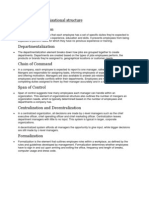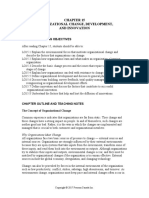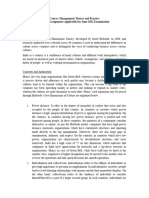Relationship Between Organizational Structure
Uploaded by
Reuben EscarlanRelationship Between Organizational Structure
Uploaded by
Reuben EscarlanRelationship Between Organizational
Structure, Design & Change
Relationship Between Organizational Structure and Culture
Organizational structure determines the organizational behavior and influences the organizational culture.
In addition, design of the organizational structure often determines how flexible or adaptable it is to
change.
The linkages between the design of the organizational structure and its resistance or acceptance to
change are indeed deep. For instance, it is common for technology organizations to have a relatively flat
structure because of the nature of the industry that is rapidly changing.
Considering that technology companies ought to be flexible and adaptable to changes in their
environment that is fast paced and always in flux, such organizations design their structure with less
hierarchy and more openness.
Manufacturing Organizations
On the other hand, manufacturing organizations have well developed and deep hierarchies mainly
because they need the differentiation between blue collar workers and white collar executives.
These terms have come about because the shop floor workers often wear blue uniforms whereas the
executives and the engineers often wear white shirts. Having said that, it must be noted that this is not
always the case and since the terms have been in use throughout the history of organizational behavior,
they are used for convenience.
Manufacturing organizations also need hierarchies since they operate on a command and control mode
meaning that the decisions are made at the top and percolate to the bottom instead of the knowledge
organizations or the services sector wherein the employees often are more autonomous in addition to
their being creative and innovative.
Turning to the relationship between organizational structure and culture, we find that in manufacturing
organizations, the employees address each other with honorifics rather than on an informal or first name
basis as is the case with the services sector. This creates a culture that is more formal and governed by
rules and regulations covering all aspects of organizational culture.
Indeed, it is very common for manufacturing organizations to have separate canteens and lunch areas for
the workers and the engineers and the executives. One rarely finds a manufacturing organization that has
workers and executives mingling with each other except for business purposes.
Software and Technology Companies
On the other hand, most software companies and financial services companies have codes of conduct
that specify addressing each other on a first name basis in addition to having common public areas and
dining halls where there is no difference between the software engineers and the managers or for that
matter even senior management. Of course, some multinationals have executive dining halls mainly
because of the fact that external clients tend to visit for meetings and hence, the negotiations and
discussions are carried out over lunch and dinner as well.
Industry Characteristics Drives Organizational Structure
The reason for mentioning all these aspects of organizational culture is that each industry has different
environmental characteristics and drivers of growth and hence, the organizations in them have
their own sets of rules that determine the structure and design of job roles and responsibilities.
For instance, workers in manufacturing organizations just need to work as they are told and that too in a
routine and repetitive manner.
Further, the assembly line mode of manufacturing means that unless there is significant innovation and
improvement, the basic work remains the same. On the other hand, the technology companies have jobs
where each day is different and each project and parcel of work has to be handled differently and in a
new manner. This means that there is constant change and hence, the culture as well as the design of
the organizational structure has to be as adaptable and flexible as possible to encourage innovation and
stimulate creativity.
Geography and Type of Organizations Play a Role as well
Finally, the design of the organizational structure is also determined according to the geography, type of
organization, and the vision of the founders and the continuing vision of the CEOS. For instance, it is
common for western multinationals to be informal and flexible whereas Asian companies are
often rigid and strict and formal in their approach. Even the technology companies in Asia often have
different designs of organizational structure when compared to technology multinationals.
The design of the organizational structure depends to a great extent on how the original founders want
the organization to be and how well the same vision is either being carried forward or being changed by
the new incumbents. This can be seen in many family promoted/owned businesses which once the initial
founders retire often have major changes in the way the organizational structure is designed.
You might also like
- Module 2 Good Governance and Social Responsibility78% (9)Module 2 Good Governance and Social Responsibility21 pages
- Organization & Management (OrgMan) Grade 11 ABM Reviewer100% (17)Organization & Management (OrgMan) Grade 11 ABM Reviewer18 pages
- Chapter 7 - Organizational Structure and ChangeNo ratings yetChapter 7 - Organizational Structure and Change5 pages
- TCS Building Resilient Organizations Through Cultural Transformation PDFNo ratings yetTCS Building Resilient Organizations Through Cultural Transformation PDF13 pages
- Natividad, Napoleon BSBA QM - Monograph - Impact of Organizational Culture To Quality Management SystemNo ratings yetNatividad, Napoleon BSBA QM - Monograph - Impact of Organizational Culture To Quality Management System13 pages
- Elements of Organisational Structure Work SpecializationNo ratings yetElements of Organisational Structure Work Specialization6 pages
- MANAGEMENT FOR CORPORATE CHANGE - WEEK 4 ASSIGNMENTNo ratings yetMANAGEMENT FOR CORPORATE CHANGE - WEEK 4 ASSIGNMENT13 pages
- Organisation Development: Incorporated by Royal Charter, Registered Charity No. 1079797No ratings yetOrganisation Development: Incorporated by Royal Charter, Registered Charity No. 10797978 pages
- Lesson 1-WHAT IS Organizational BehaviorNo ratings yetLesson 1-WHAT IS Organizational Behavior23 pages
- Chapter One Organizations and Organization Theory: Current ChallengesNo ratings yetChapter One Organizations and Organization Theory: Current Challenges6 pages
- Cultura Organizacional Nueva Tendencia de La Gerencia de Recursos Hacia La CompetividadNo ratings yetCultura Organizacional Nueva Tendencia de La Gerencia de Recursos Hacia La Competividad4 pages
- Individual Assignment On Chapter Seven & Eight-OBNo ratings yetIndividual Assignment On Chapter Seven & Eight-OB10 pages
- Organization Structure and Design Notes Chapter 10No ratings yetOrganization Structure and Design Notes Chapter 107 pages
- Chapter 10 - Organizational Processes and Characteristics0% (1)Chapter 10 - Organizational Processes and Characteristics3 pages
- Types of Environmental Change & Factors Affecting Environmental ChangeNo ratings yetTypes of Environmental Change & Factors Affecting Environmental Change6 pages
- Lawler, E. The Ultimate Advantage. Cap. 3, 7 y 8No ratings yetLawler, E. The Ultimate Advantage. Cap. 3, 7 y 885 pages
- Organisational Change and Stress ManagementNo ratings yetOrganisational Change and Stress Management18 pages
- Organization Development in the 21St Century: An Organizational Behavior, Organization Development and Process Consultation GuideFrom EverandOrganization Development in the 21St Century: An Organizational Behavior, Organization Development and Process Consultation GuideNo ratings yet
- Why Is Financial Management So Important in BusinessNo ratings yetWhy Is Financial Management So Important in Business3 pages
- How To Lead, Manage and Motivate Knowledge WorkersNo ratings yetHow To Lead, Manage and Motivate Knowledge Workers16 pages
- Role of HR Consulting in Redesigning Organizational StructureNo ratings yetRole of HR Consulting in Redesigning Organizational Structure3 pages
- The Great Chinese General, Military Strategist, and Philosopher Sun Tzu Once SaidNo ratings yetThe Great Chinese General, Military Strategist, and Philosopher Sun Tzu Once Said2 pages
- The Puzzle of Internet Plagiarism and Instructional DesignNo ratings yetThe Puzzle of Internet Plagiarism and Instructional Design83 pages
- Employee Satisfaction Survey Questions:: 3 Sample Templates You Can Use Today100% (1)Employee Satisfaction Survey Questions:: 3 Sample Templates You Can Use Today8 pages
- Spiritual Intelligence and Job-Satisfaction of Higher Secondary School's TeachersNo ratings yetSpiritual Intelligence and Job-Satisfaction of Higher Secondary School's Teachers211 pages
- Management Theory Assignment Answers June 2022No ratings yetManagement Theory Assignment Answers June 202210 pages
- ADM 1100 Introduction To Business Management: October 31No ratings yetADM 1100 Introduction To Business Management: October 3146 pages
- Organizations Structures Processes and Outcomes Pamela S. Tolbert - The ebook with rich content is ready for you to downloadNo ratings yetOrganizations Structures Processes and Outcomes Pamela S. Tolbert - The ebook with rich content is ready for you to download47 pages
- Principles of Management May 2024 Semester AssignmentNo ratings yetPrinciples of Management May 2024 Semester Assignment12 pages
- Organisational Behaviour II A Project Report On India Yamaha MotorsNo ratings yetOrganisational Behaviour II A Project Report On India Yamaha Motors28 pages
- Uloga Voditelja Projekta I Problemi S Kojima Se Susrece U Praksi v3.0No ratings yetUloga Voditelja Projekta I Problemi S Kojima Se Susrece U Praksi v3.044 pages
- FMOB RESEARCH PAPER - Organising As A Function of ManagementNo ratings yetFMOB RESEARCH PAPER - Organising As A Function of Management16 pages










































































































